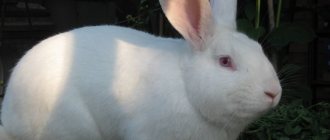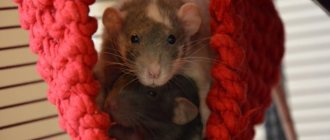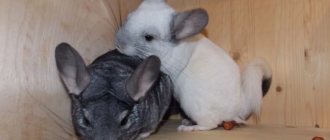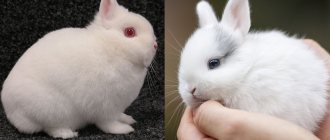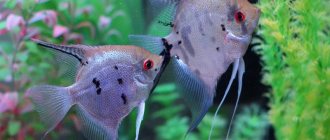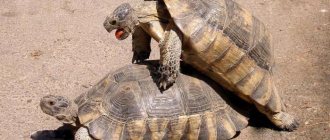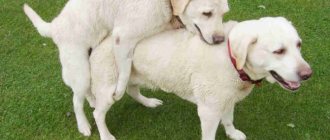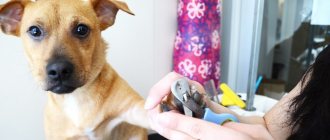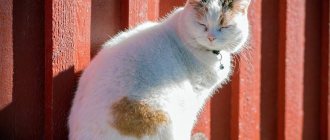At what age can rabbits be born?
Rabbits of early maturing breeds are physiologically ready for the first mating at 3–4 months, and late maturing ones at 6 months. However, the onset of puberty does not mean that the animal’s body is ready for pregnancy and childbirth. If you allow a female to mate at such an early age, there is a high risk of complications during birth. The offspring may be born weak or non-viable.
Some meat farms practice early breeding of rabbits of early maturing breeds - at the age of 4 months. Such females are called “disposable” because they bear offspring once in their lives and then are discarded. The purpose of such early mating is to quickly obtain young animals intended for meat. Good results are possible only with absolute health of the livestock and adequate feeding with special compounds.
For the first time, animals are allowed to mate no earlier than they are six months old. Representatives of late maturing breeds are ready to breed at 8–9 months. The indicated age is valid for females; the rabbit can be mated a couple of months earlier.
Jigging methods
Weaning small rabbits is important. For rabbit breeding, it is recommended to plant at 45 days. There are two methods of depositing:
- Removal of the entire brood at the same time.
- The female is taken away from the babies and sometimes returned for 1-2 days.
- Seated gradually. First the strongest and strongest, and over time those who are weaker.
After transplanting, the young animals are weighed and placed in different cages. Some (strong and strong) will serve for reproduction, others will be used for meat.
How to tell if a female rabbit is in heat
To successfully breed rabbits, you need to know when you can assign a female to a male. She is ready to accept a rabbit not at any time, but only on certain days. The reproductive cycle of a female rabbit lasts on average 20–22 days. During this period, the egg matures and is ready for fertilization, the female can be mated. If the result does not occur, the female rabbit comes into heat again after 22 days.
You can tell that the female is ready for mating by her changed behavior:
- shows anxiety;
- refuses food, throws food out of feeders;
- runs around the cage;
- may start biting.
In some cases, the nursing female tramples the offspring and scatters them around the cage.
One of the signs of the onset of heat is swelling and redness of the female's genital loop.
Sometimes the female rabbit walks quietly, not outwardly showing any readiness for mating. In this case, you can determine if the female rabbit is in heat by letting the male near her. She is taken to the rabbit and placed in a cage for half an hour. If the female is not in heat, she will run away from the male, squeak displeasedly and even try to bite the intrusive gentleman. A female rabbit, ready to mate, will calmly allow the rabbit to cage.
Why does a female kill her cubs?
Decorative rabbits, whose reproduction is a fairly fast process, sometimes, however, eat their litter immediately after giving birth. There may be several reasons for this. The main one is the painful condition of the rabbit’s nipples – mastitis. You can reduce the risk of this phenomenon by carefully monitoring the cleanliness of the cage. Another reason for eating litter may be the lack of milk. It is believed that this can happen if during pregnancy the female did not receive enough food or there was no water in her cage at the time of birth.
Some farmers also cite the presence of foreign odors as a possible reason for the biting of baby rabbits. And not only strangers, but also other – especially recently acquired – females.
Up to what age can rabbits be born?
Depending on the health of the animal and the intensity of use, females are kept in a productive herd for up to 3–4 years. If problems with the appearance of heat and childbirth (the number of stillbirths increases, the female does not have enough milk for all the babies) appear before the age of 4, the female rabbit must be culled.
If we take as an example ordinary meat-skin rabbits with an average weight of 5 kg, then rabbits begin to be covered at the age of 6 months. During the year, a female receives 2–4 litters, sometimes 5–6 if intensive use is used. With 3 litters per year, the animal retains its reproductive qualities longer. With intensive breeding, the female rabbit is culled in the second year.
When animals are kept not in rabbit hutches, but on the street, the mating of rabbits depends on the weather - in the cold season the animals are at rest.
Terms of breeding use
The breed and feeding conditions of rabbits significantly affect their early maturity. If you want to further increase their early maturity, try to ensure that both the keeping and care of the rabbits are at their best. The first time the female begins to hunt at approximately three to four months, but it should be a fact for you that at this age the animal will not be able to bring you viable and vigorous babies. Healthy offspring can only be obtained from a normally developed female. Each individual breed of rabbit will be formed exclusively according to its own characteristics. For example, breeds such as Viennese blue or chinchilla will give birth to healthy offspring at approximately five months, and breeds such as giant (gray or white) at six months and their weight will be 3.5-3.8 kilograms.
Mating rabbits at this age will allow rabbit farms to develop well, and within one year you will receive offspring not from one rabbit, but also from her babies (grown up) from the initial and second litters. It is believed that a satisfactory litter can be obtained if your female is one year old. This is really so, because then they can not only bear offspring, but they will also have enough milk to feed the cubs up to the age of one and a half months. In addition, you will receive rabbits that will differ in size, resistance to various diseases and good immunity.
Mating technologies
Large rabbit farms often use artificial insemination of rabbits in order to reduce the number of breeding males. Seeds are collected from the most valuable specimens, which can be stored for many years in special containers, deep frozen. To inseminate a female rabbit, a portion of semen is injected into her with a special syringe. The effectiveness of this method is high; a prerequisite is the necessary qualifications of veterinary specialists and the availability of equipment.
On small farms and when keeping animals indoors, natural mating is practiced. Rabbits begin to show interest in the opposite sex quite early, so young animals are sorted by gender already at the age of 3 months.
Feeding baby rabbits
After giving birth, which usually occurs at night or early in the morning, the mother rabbit licks the babies and begins to feed them. The baby in the litter only needs its mother's milk. Then he covers them with down, eats his afterbirth and drinks water. Important! If she does not have enough water, the female may eat the rabbits.
After giving birth, the behavior of the uterus needs to be monitored. Sometimes a mother rabbit may abandon her babies. If you notice babies scattered around the cage, collect them in a nest and cover them with down. Place the female. And here you already have two options - either add the babies to another female thrush, or feed them artificially. For a baby rabbit to survive, it needs warmth and food.
Mating schedule and male diet
When planning a breeding schedule for rabbits at home, it is necessary to correctly distribute the load on the producer. Depending on the age and breed, it can range from 1 to 3 rabbits per day.
The male is first allowed to work at the age of 5 months. An experienced female rabbit, who has already given birth, is being prepared for him and is in a pronounced heat. Bringing two young and inexperienced animals together may not be productive.
For a young male, a small load is set - 1 female every other day. Gradually the norm is increased to 3 individuals per day, provided that the male feels well. High strain on the producer can increase the percentage of unfertilized individuals.
Slow and phlegmatic giant rabbits are bred no more than once a day with a mandatory rest day twice a month.
To maintain high sexual activity, it is necessary to provide rabbits with a fortified and varied diet, preventing the animals from becoming obese. In the diet they use:
- cereal or meadow hay (brome, wheatgrass, vetch-oat mixture) - up to 250 g;
- oat and barley grain - up to 120 g;
- carrots, parsley root - up to 150 g.
Experienced rabbit breeders give their animals fresh pine needles, parsley, and sprouted oats to increase libido. In winter, the livestock is given a vitamin complex.
Preparing for birth
The pregnant female should be completely at rest. The animal is kept in another cage, which should always be dry and clean. It is not recommended to pick up the rabbit during this period. Diet is very important. The animal is fed high-quality food: hay, cereals, legumes, succulent food (cabbage, carrots, washed potatoes). If it's summer, then the diet should include fresh grass. Improper feeding (lack of vitamins and minerals) can lead to the female eating the rabbits.
A few days before giving birth, females build a nest from straw and their own down. There should always be fresh water in the cage (slightly warmed in winter).
How to breed rabbits correctly
Beginning rabbit breeders need to know how rabbits are mated at home. The normal process goes like this:
- A female in heat is placed next to a selected male in a cage.
- The rabbit sniffs the female rabbit, sometimes lightly biting her fur. She lifts her sacrum and lifts her ponytail up.
- The male attaches himself to the female rabbit and intercourse occurs. It lasts for several seconds, after which the rabbit falls on its side with a characteristic loud squeak. This signals ejaculation.
- Repeated intercourse may occur within a few minutes.
It is not recommended to leave the female rabbit with the male all night. During this time, he can bring up to 10 cages, which significantly depletes the rabbit’s strength and is harmful to the female.
Rejection
After the rabbits have been mated several times, it is necessary to cull the sires. At the same time, they get rid of those rabbits whose efforts to procreate were unsuccessful in more than 30% of cases. Females are also culled:
- Those who ate their rabbits or aborted more than two times in a row.
- Those who did not become pregnant even after a control mating.
- Carried and nursed less than four rabbits in two litters in a row.
Of course, it is best to leave only high-milk rabbits as producers.
Mating rabbits in winter
Breeding rabbits in winter can be difficult, not only because of the cold, but also because of the short daylight hours. If animals are indoors, fluorescent lamps are turned on for them, extending the daylight hours to 10–14 hours.
Female rabbits kept outside or in sheds stop coming into heat in the fall. Hormonal levels are restored in March - April. To “deceive” nature, animals are injected with a complex of vitamins (vitamin E is responsible for reproductive function). Rabbits can be temporarily placed in a warm, bright room to encourage the onset of heat.
Sign of sexual intercourse
A sign of successful ejaculation is characterized by the male falling to the side or back, accompanied by a characteristic rumbling or squeaking sound. Without this, it is considered that mating did not take place.
If you think that copulation did not take place.
- Then after 10-20 minutes or after 3-7 hours the mounting is repeated with another male - this is a duplicate mating of rabbits.
- Control mating is carried out after five days. For this purpose, females who have returned to heat after a previous mating are selected.
Already pregnant females can come into the hunt - a feature of rabbits
When can you give birth to a female rabbit after giving birth?
Theoretically, the female is ready for fertilization already on the 5th–7th day after birth. A special feature of the animals is the ability to combine feeding existing offspring with a new pregnancy. However, this is a large burden on the mother’s body, which leads to early aging of the rabbit.
The female should be covered no earlier than 1.5–2 months after birth. This coincides with the birth of the previous offspring and gives the mother the opportunity to rest for a month before the next litter.
Forced or accidental inbreeding
Reasons for random inbreeding:
- breeding within one small holding, farm,
- random covering in cages with unseated young rabbits,
- Inbreeding is inevitable when pitting animals.
As a result, a family with developmental disorders consistently passes on these anomalies to new generations. For example, the offspring of a female rabbit with weak maternal instincts or weak milk production copies these shortcomings.
Close inbreeding is very dangerous: father - daughter, mother - son, sister - brother, closely related: cousins - sisters, uncles - nieces.
Gene mutation leads to the fact that ugly, weak and with physical abnormalities rabbits are more often born in the herd. As a result, the viability of the offspring gradually decreases.
In order to avoid inbreeding, it is recommended to create parental pairs from rabbits from other farms.
Forced inbreeding is used in breeding to develop new or improve existing breeds.
What to do if the female rabbit does not want to mate
Mating of rabbits is impossible if the female does not allow the male to approach her. This happens for several reasons:
- the female rabbit is exhausted from previous births and feeding offspring;
- the female has become fat;
- advanced age of the animal;
- The time of year is not conducive to hunting.
Sometimes a rabbit experiences a hormonal imbalance, which is difficult to determine with a routine examination. If an animal, with proper care and feeding, does not show readiness for mating, it can be stimulated by administering special drugs: Folligon, Folimag. The solution is administered to individuals subcutaneously or intramuscularly, according to the instructions.
Determination of gender
Before you start breeding rabbits, you should determine their gender. This is not as simple as it might seem at first glance. Moreover, such an activity will seem difficult for a person who is encountering this for the first time.
To determine the sex, you need to place the rabbit on its back, lower its tail, and press with your fingers on both sides near the rabbit's genitals. In a female individual, the genitals look like a loop or hood with a slit (genital slit). In males, the genital organ is formed in the form of a tube with a round hole in the middle.
Lay the rabbit on its back
Press on both sides to bring out the genitals
The female genitalia looks like a loop
Female rabbit genital slit
The male rabbit's external genitalia has the shape of a tube.
Rabbit reproductive organ
How to determine pregnancy
After mating, the female completely loses interest in the rabbit and may become aggressive. One of the simplest ways to check for pregnancy is a male test. The covered rabbit runs away from the rabbit or attacks it.
Experienced rabbit breeders can feel the embryos in the female’s abdomen 14–16 days after mating. To do this, the rabbit is placed on a flat surface and her lower abdomen is carefully felt. The fruits during this period are the size of a walnut and are soft to the touch.
If the female rabbit is not pregnant and does not become pregnant for 2-3 months, she is subject to culling.
Advice from experienced rabbit breeders
One of the main advantages of rabbit breeding is the ability of animals to reproduce quickly. Having several females, in just a year you can increase the population to hundreds of individuals.
Beginner rabbit breeders are advised to:
- mate rabbits that have reached the age of 6–9 months;
- choose unrelated healthy animals;
- receive no more than 4 litters per year from a female.
Caring for the animals guarantees good health of the livestock and numerous births. It is important to consider the age and condition of the animals. You cannot breed sick or weak individuals - their offspring will be frail and non-viable.
Quick search:
✦ How does breeding work affect the quantity and quality of litters?
✦ A few small but useful tips. ✦ About monitoring the age of young animals and the importance of determining the sex of rabbits. ✦ What is the period of sexual heat in a female rabbit? ✦ Features of the female rabbit’s reproductive system. ✦ What breeds should you cross? ✦ Compacted and semi-compacted litters. ✦ Technology for mating rabbits. ✦ How can you be sure to check whether coverage has occurred? ✦ Optimal age for parent couples. ✦ Until what age should rabbits be kept for breeding? ✍️ Go to the comments and ask a question.
